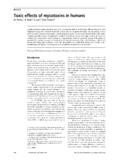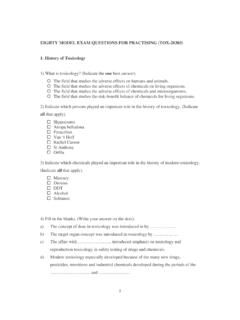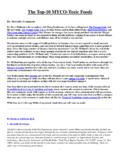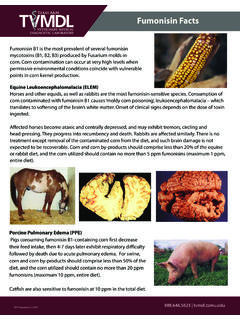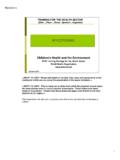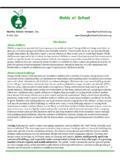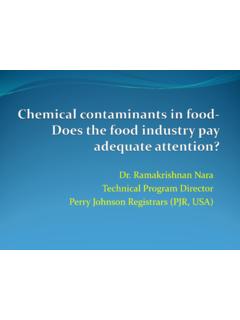Transcription of SECTION 1 Health hazards associated with animal …
1 USDAH ealth hazards associated with animal feedSECTION 1 INTRODUCTIONFood safety hazards associated with animal feed can be biological, chemical or physical. Each hazard is associated with particular sources and routes of contamination and exposure. Risk management must be based on a thorough understanding of these characteristics. The role of water as a potential source of hazards should not be overlooked. hazards may be introduced with source materials or via carryover or conta-mination of products during handling, storage and transportation. The presence of a hazard may also result from accidental or deliberate ( fraud or bioterrorism) human intervention.
2 Risk management should be based upon prepa-redness and prevention rather than reaction after detection of the problem. Important issues that have contributed to this evolution include:(i) Bovine Spongiform Encephalopathy (BSE) and other prion diseases;(ii) impact on food safety of antimicrobial use in animals;(iii) newly recognized undesirable substances: melamine, dioxins, dibenzofurans and dioxin-like polychlorinated biphenyls (PCBs);(iv) the presence of genetically modified orga-nisms, crops and enzymes in feed ;(v) by-products of new technologies ( bio-fuel production) used in feed production;(vi) radionuclides.
3 (vii) development of aquaculture industries and the search for new/better aquaculture feeds;(viii) feed (and food) as the target of bioterrorism; and(ix) emerging technologies, such as the use of products of nanotechnology in feed .(x) Selection of undesirable substances and micro-organisms of concernThe following criteria have been used to select hazards of current importance in feed :(i) relevance of the hazard to public Health ;(ii) extent of the occurrence of the hazard; (iii) impact of the hazard on international trade in food and others, the following feeds and feed ingredients are considered:t DPNQPVOE DPNQMFUF GFFET t HSBJOT BOE PJMTFFET XIPMF BOE NFBMT GSVJU BOE vegetable by-products, including oils.
4 T GPSBHF JODMVEJOH HSBTTFT IBZ BOE TJMBHF t EJSFDUMZ ESJFE QSPEVDUT F H CBLFSZ CZ QSPEVDUT t CJPGVFM CZ QSPEVDUT F H EJTUJMMFST HSBJOT XJUI solubles (DGS), dried distillers grains with solubles (DDGS) and glycerol);t GPPE QSPDFTTJOH CZ QSPEVDUT BOE DP QSPEVDUT t NJOFSBMT JODMVEJOH USBDF FMFNFOUT BOE CJOEFST t BOJNBM CZ QSPEVDUT JODMVEJOH NFBU BOE CPOF meal and fats;t BRVBUJD QSPEVDUT JODMVEJOH GJTINFBM TIFMMGJTI fish by-products, seaweed and krill;t GFSNFOUBUJPO CJPNBTT BOE ESJFE QSPEVDUT t WJBCMF NJDSPCFT t TJMBHF BEEJUJWFT The following undesirable substances and micro-organisms are currently considered to be the most important:CHEMICAL SUBSTANCESD ioxins, dibenzofurans, and dioxin-like PCBs (dioxins)Because of the ubiquitous presence of dioxins in the environment, the threat of dioxin contami-nation posed by feed ingredients may originate from many different sources.
5 Since the Bel-gian dioxin crisis in 1999, dioxins have become important considerations for feed safety. Since then, numerous cases of contamination invol-ving dioxin from unexpected sources have been reported. This has shown that dioxins may be inherent to a product ( clay minerals), or introduced during processing ( lime in citrus pulp). Dioxins can be introduced if contaminated fuels are used in the drying of feed products; for example treated wood, poor quality coal or contaminated fuel oil. Dioxins have also been known to contaminate forage crops grown in the vicinity of certain industrial processes ( incinerators).
6 Dioxins and dioxin-like PCBs are two related groups of toxic compounds, both comprising a number of congeners. Each congener has its own toxicity as expressed by the toxicity equivalence factor (TEF).It has been postulated that most human expo-sure to dioxins is as a result of foods of animal origin, which in turn may arise from the presence of dioxins in animal feeds. Dioxins accumulate in fat to a high degree, so even extremely low levels of dioxin in feed can become significant over the lifetime of an animal and result in unacceptable residues in human foods such as meat, milk, and eggs.
7 Toxicokinetic models have been developed to estimate the transfer rates of dioxins to animal tissues (Van Eijkeren et al. 2006)As such, implementing controls for dioxins in feed represents an important step towards reducing dioxins in the food chain. In particu-lar, screening programmes have indicated that Health hazards associated with animal feed3 SECTION 1of the following transfers from feed to food: aflatoxin B1 to liver, aflatoxin B1 to milk as aflatoxin M1, aflatoxin B1 to eggs as aflatoxicol; ochratoxin A to meat; deoxynivalenol to meat as DOM1; zearalenone to meat as zearalenol, evaluating transfer rate and route of exposure in humans is restricted to aflatoxin B1 for animals producing should bear in mind that animals fed on aflatoxin contaminated feed do not show symptoms of aflatoxin most susceptible to aflatoxin are: cereals (especially maize), cottonseed, peanut, copra, palm kernel and rice bran but caution is required with any feed products grown in tropical and sub-tropical regions, particularly where they are not dried or processed promptly after harvesting.
8 Aflatoxin contamination is not homogeneous; it is therefore very important to apply an appropriate sampling method. Feeds having a significant aflatoxin contamination should not be fed to dairy cows or other ani-mals producing milk for human consumption or to other food-producing may arise in feed via their presence in mineral sources, such as clays, recuperated copper sulphate, zinc oxide; food by-products; and fish by-products such as fish meal and fish is a need for development/improvement of inexpensive and accurate screening methods. feed and food exposure studies are necessary to account for all sources of dioxin entering the feed : Aflatoxin B1In the last decade, many studies have been conducted on mycotoxins.
9 Most frequently occur-ring mycotoxins (aflatoxin B1, ochratoxin A, zea-ralenone, fumonisin B1, deoxinivalenol, T-2 and HT-2) are currently considered for their effects on animal , when focusing on how mycotoxins play a role in food safety, attention should be limited to mycotoxins that are known to be trans-ferred from feed to food of animal origin, as this food represents a significant route of exposure for the scientific community is aware TABLE 1. Minerals, their sources and bioaccumulation in animal tissuesMineralSourcesBioaccumulation in animal tissues:Arsenic (inorganic)Sea plants, fish products and supplemental mineralsFishCadmiumMineral supplements (such as phosphate, zinc sources)Forage/grains (depending on geographical area)Manure, sewage, sludge or phosphate fertilizers can enrich soilKidney and liverShellfish, oysters, salmon and fungi, have the highest concentrationsThere are low concentrations in fruits, dairy products, legumes, meat, eggs and poultryLeadContaminated soil, lead paints, water from plumbing systems that contain lead, batteriesMineral supplements (copper sulphate, zinc sulphate, zinc oxide)
10 Lead is also a natural contaminant of calcium carbonate (limestone) in some regionsBone, brain and kidneyMercury/methyl mercuryAnthropogenic contamination, fish mealLiver, kidneyFish, marine mammalsSource: NRC. 2005. Mineral tolerance of animals. Washington DC, National Research CouncilManual of Good Practices for the feed Industry4could accumulate these substances, which are extremely persistent and which decompose very slowly. Contaminated animal products can cause food safety issues for hazardsThe primary sources of microbiological hazards in feed are contaminated pasture land, forages and animal and vegetable protein meals fed directly to some countries, where Brucella infection occurs, infected ruminants can deliver offspring or abort in fields that are grazed or from which pasture is harvested and used for animal feed .










